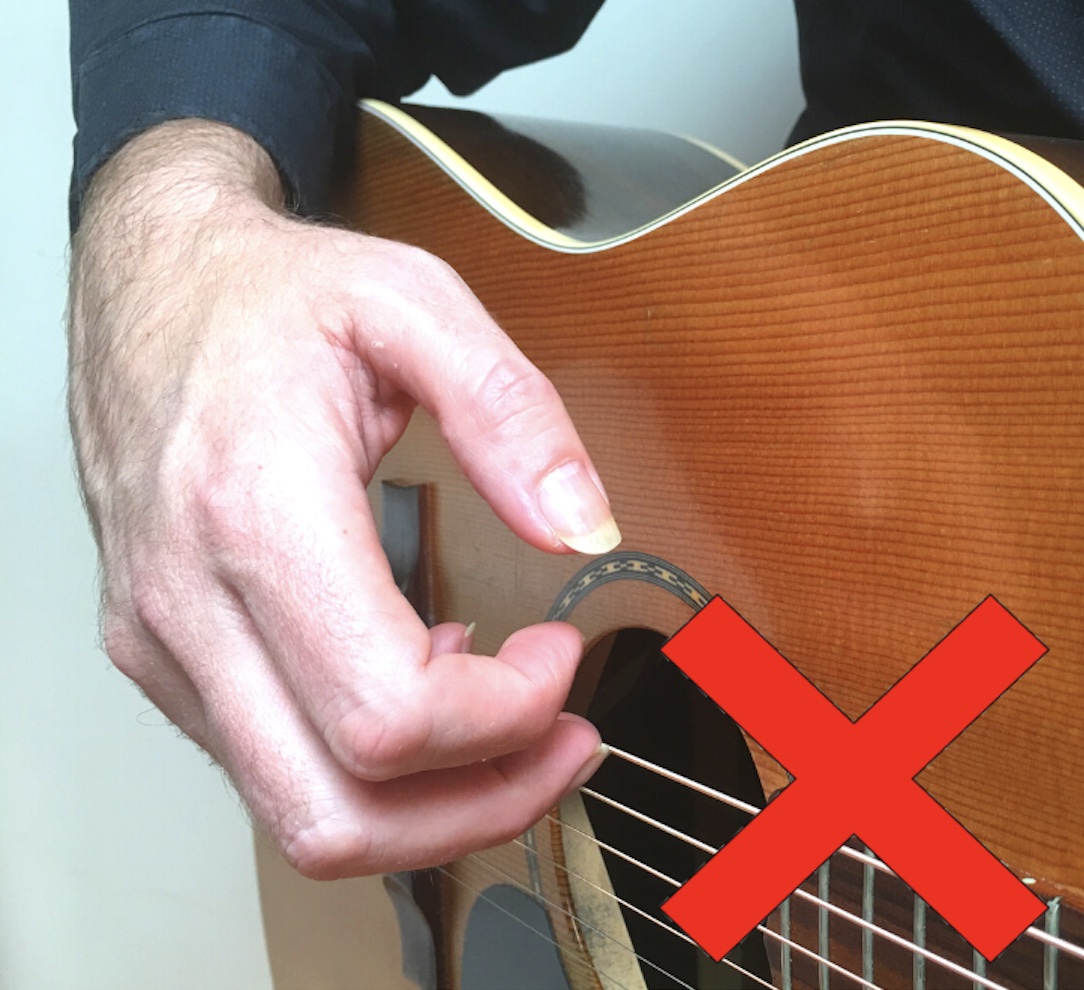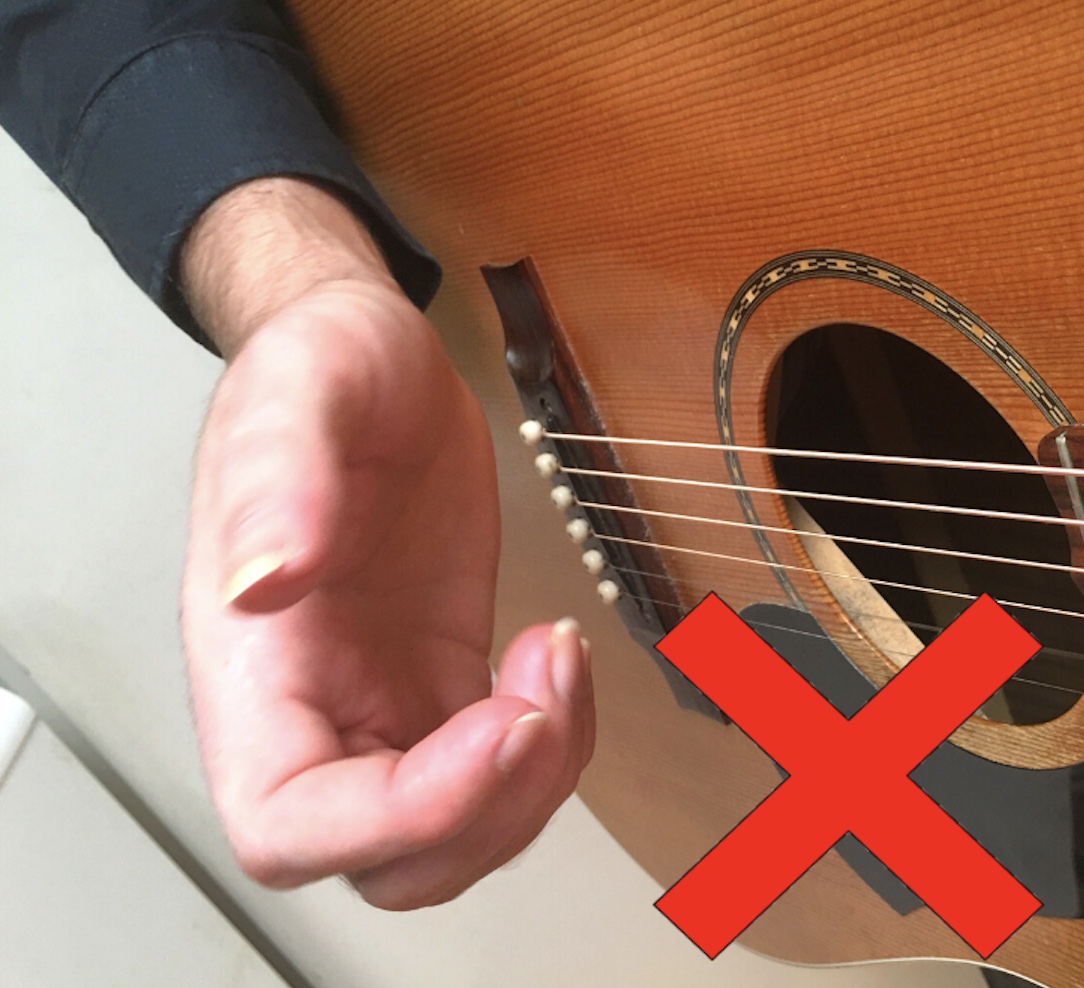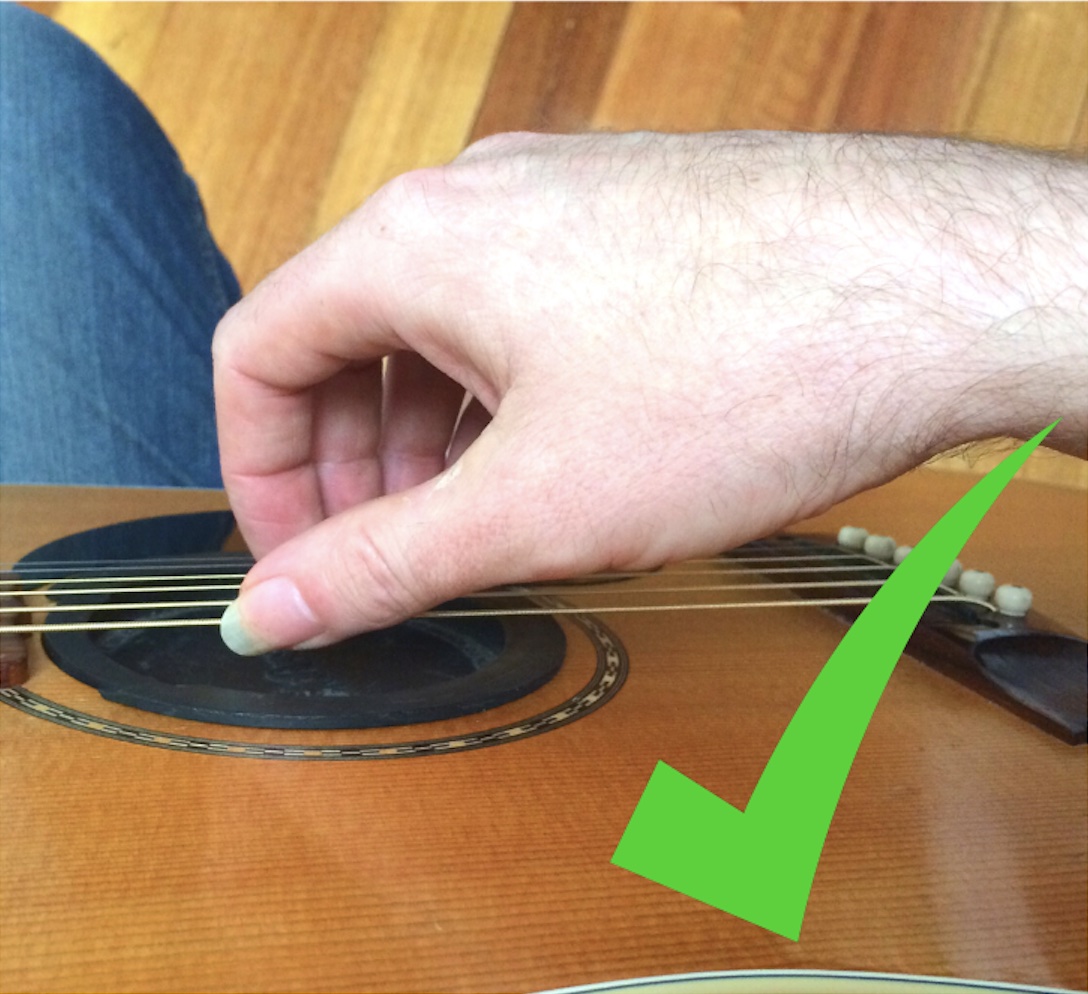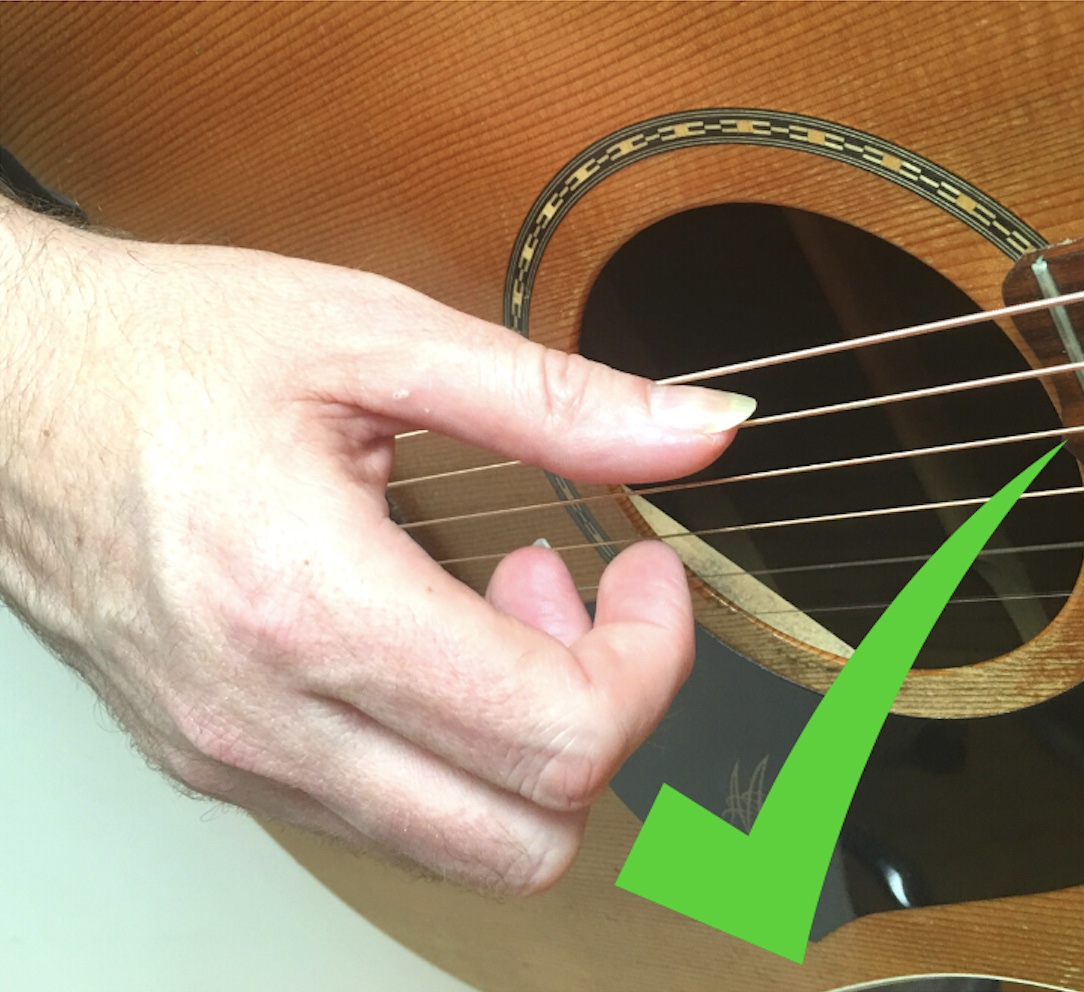Fingerpicking The Easy Way Versus Fingerpicking The Right Way
By Simon Candy
 Learning how to fingerpick your guitar can expand your playing possibilities significantly. With fingerpicking, you can do things that would be impossible with a pick or strumming.
Learning how to fingerpick your guitar can expand your playing possibilities significantly. With fingerpicking, you can do things that would be impossible with a pick or strumming.
However, a common mistake beginners make is choosing what feels easy for them instead of what is correct. Opting for an easy approach will only lead to incorrect, inefficient, and problematic fingerpicking technique.
This creates a weak foundation for all your fingerpicking playing and will significantly limit what you can achieve with the technique in the songs that you want to play or write on your guitar in the future.
But, what is the correct fingerpicking technique, and how can you ensure that you do not opt for an easier method?
In this article, we will address this question in detail, so that you can differentiate between the right and easy approach when it comes to learning how to fingerpick your guitar.
Fingerpicking The Easy Way
Let’s take a look at the “easy” way to fingerpick your guitar.
To me, easy is doing what feels natural to you when exploring this technique.
Taking this approach doesn’t necessarily mean you are only going to make poor choices, but it significantly increases the chances that you will, of which there are 3 main issues that can and most probably will arise:
1. Poor finger choice
 Going the easy way almost always leads to poor finger choice when fingerpicking your guitar. Poor finger choice could be defined as using whatever finger feels comfortable to you at the time to pick the strings, and in turn, will lead to very inefficient movements which leads to bad fingerpicking technique.
Going the easy way almost always leads to poor finger choice when fingerpicking your guitar. Poor finger choice could be defined as using whatever finger feels comfortable to you at the time to pick the strings, and in turn, will lead to very inefficient movements which leads to bad fingerpicking technique.
This is a classic case of going with what feels easy. It is very unlikely that choosing whatever fingers feel comfortable to you in the beginning, just happens to be the right finger choice too.
Don’t leave it to chance!
2. Incorrect picking hand position
 Another symptom of going with what feels easy is the position of your picking hand and the angle of your fingers to the strings. Get this wrong and it won’t even matter if you are using the correct fingers to pick your strings or not. This is because your fingers will be approaching the strings from the wrong angle, resulting in you not getting the leverage needed to pluck the string effectively. Again, this severely limits your fingerpicking technique.
Another symptom of going with what feels easy is the position of your picking hand and the angle of your fingers to the strings. Get this wrong and it won’t even matter if you are using the correct fingers to pick your strings or not. This is because your fingers will be approaching the strings from the wrong angle, resulting in you not getting the leverage needed to pluck the string effectively. Again, this severely limits your fingerpicking technique.
I see this particular issue with a lot of fingerpickers, and while you will still get sound from plucking the strings this way, you will be attacking the strings from a position of weakness.
3. Inefficient movements
 Don't let the hand or arm you’re using to fingerpick itself have inefficient movements. In fact, if your arm has any movement at all it's a big problem and will certainly get in the way of you and a great technique for fingerpicking your guitar. Another symptom of the DIY approach to fingerpicking guitar.
Don't let the hand or arm you’re using to fingerpick itself have inefficient movements. In fact, if your arm has any movement at all it's a big problem and will certainly get in the way of you and a great technique for fingerpicking your guitar. Another symptom of the DIY approach to fingerpicking guitar.
Fingerpicking The Right Way
So then, what is the right way to fingerpick your guitar?
To be honest, there is no one right way to fingerpick a guitar. Even if you study the playing techniques of great fingerpickers like Tommy Emmanuel or Martin Taylor, you will find differences in their approach.
However, what remains the same are the fundamental techniques that form the basis of their impressive skills.
And that is the point, get the fundamentals right with your fingerpicking and the rest will take care of itself.
So let’s now look at these fundamental areas by addressing the 3 main problems caused by taking the easy way with fingerpicking your guitar.
1. Use good, efficient, logical finger choices.
 Here is a guide to follow for building a strong fingerpicking foundation for your playing:
Here is a guide to follow for building a strong fingerpicking foundation for your playing:
• Thumb (p) plays notes on the lower 3 bass strings of your guitar (ie. the E, A, and D strings).
• Index finger (i) plays notes on the third string (G).
• Middle finger (m) plays notes on the second string (B).
• Ring finger (a) plays notes on the first string (E).
The fingers you use to fingerpick one thing may change slightly when fingerpicking something else. As with anything in music, context has everything to do with it. The above, however, will serve as a great starting point, a foundation if you like, to developing awesome fingerpicking skills on your guitar.
Here is a very simple but effective drill you can do to start getting used to this approach if you are either new to fingerpicking or need to break any bad habits in your technique:

Now while doing the above drill let's focus on:
2. Making sure your fingerpicking hand is in the right position.
 When using a flat pick to play your guitar, your arm and hand are at about a 45 degree angle to the strings
When using a flat pick to play your guitar, your arm and hand are at about a 45 degree angle to the strings
If you don’t change this when fingerpicking, then your fingers will also be at about a 45 degree angle to the strings. This does not allow enough leverage for your fingers to pluck the strings properly and will result in bad fingerpicking technique.
To generate more power when plucking the strings, it's important to position your fingers at a 90-degree angle to the strings. To achieve this, simply raise your picking hand's wrist higher above the strings than you normally would when using a plectrum. This will allow your fingers to be positioned correctly and generate more power when playing.
If you do not have your hand at this angle to the strings then it will cause many problems in your guitar fingerpicking technique. This is essential to get right if you are to have a good foundation to base this style of playing upon.
Watch the video below, where I share a simple 10 second process that guarantees you will have your hand in the correct position every single time for fingerpicking guitar.
It’s much easier to show you than try and explain it in words so check it out:
And finally:
3. Keep the movement to your fingers only.
 If you have mostly played your guitar with a plectrum, then you will be used to moving your wrist and arm as you play. When fingerpicking your guitar your arm and wrist mostly stay still. All the movement is generated from the fingers themselves that are plucking the strings.
If you have mostly played your guitar with a plectrum, then you will be used to moving your wrist and arm as you play. When fingerpicking your guitar your arm and wrist mostly stay still. All the movement is generated from the fingers themselves that are plucking the strings.
Resist the urge to pull away as you pluck each string with your fingers.
For more ways to make sure you are creating a strong foundation for fingerpicking guitar, check out the video below.
In it, I reinforce things covered in this article plus a lot more including the best ways to practice these fingerpicking techniques and fingerpicking in general:
How To Best Train Your Fingerpicking Technique
Here is an E7 chord vamp for you to hone your newfound fingerpicking skills:

When playing this example, rotate your focus on each key area of the fingerpicking techniques we have covered, including:
1. Using the correct fingers
Start from the foundation we have set up earlier in the article with specific fingers assigned to specific strings. In this example, as is often the case, there is no need to deviate from this. Then play it several more times and focus on:
2. The picking hand position
Are your fingers at more or less of a 90 degree angle to the strings? Is your wrist raised above the strings as opposed to how it is when flat picking?
Continue playing the example but now shift your focus to:
3. Isolated finger movement
Make sure movement is isolated to your fingers with your arm and wrist kept still.
Train your fingerpicking by rotating your focus across these 3 key areas and you will be on your way to a great fingerpicking guitar technique!
Before we finish up, it’s worth mentioning that it’s recommended to have fingernails on your picking hand so that when you pluck the strings they contribute to the sound.
I’d say it's approximately a 60/40 ratio of the nail to flesh that strikes the string. You need to file your nails so they are rounded and make sure they are not too long as they will get caught under the string when plucking.
Can you fingerpick without any nails?
Yes, but I’d suggest you go the nail approach as you will have more control and a better tone to your sound.
Watch the video below and discover 5 tips for achieving a great tone when fingerpicking guitar.
Tone is in the fingers as they say, and there are simple things you can do to get a much better sound out of your instrument when fingerpicking:
Learn 10 pro sounding fingerpicking patterns for your guitar playing